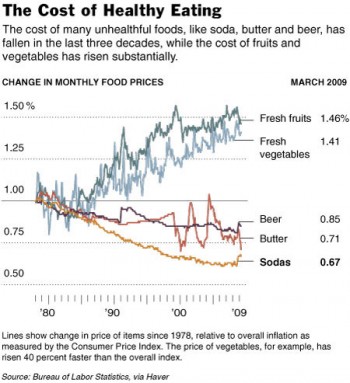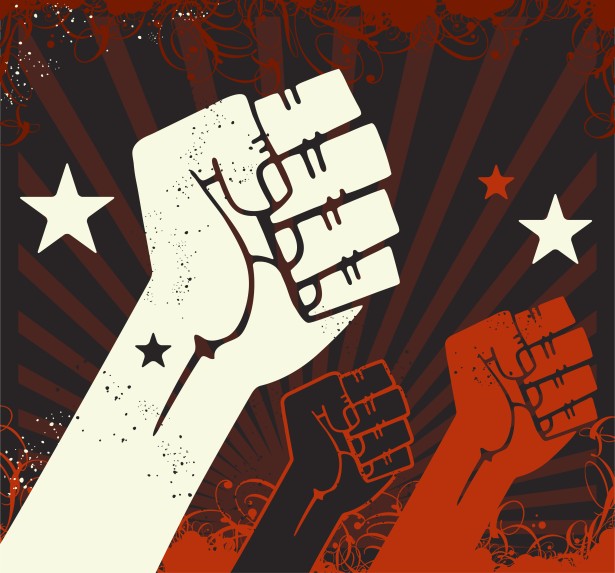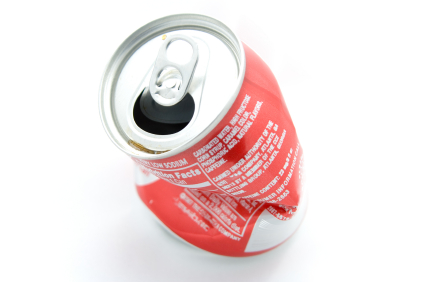 Soda can … harm your health.The taxman cometh for soft drinks. Or so it appears these days. We already know they’re on the table as a possible funding source for Obama’s health care reform. And behind the scenes, the co-author of an influential paper on the potential positive effect of soda taxes, New York City’s Health Commissioner Tom Frieden, has just been named to run the Centers for Disease Control. And today David Leonhardt, one of the NYT’s top economics writers published a column praising the benefits of taxing soda in particular and calories in general. I even learned that taxes on activities or objects we want less of have a cosmically appropriate name, at least in terms of calories. They are technically known as Pigovian taxes and are named not after our barnyard friends, but after Arthur Cecil Pigou, an English economist. But I digress.
Soda can … harm your health.The taxman cometh for soft drinks. Or so it appears these days. We already know they’re on the table as a possible funding source for Obama’s health care reform. And behind the scenes, the co-author of an influential paper on the potential positive effect of soda taxes, New York City’s Health Commissioner Tom Frieden, has just been named to run the Centers for Disease Control. And today David Leonhardt, one of the NYT’s top economics writers published a column praising the benefits of taxing soda in particular and calories in general. I even learned that taxes on activities or objects we want less of have a cosmically appropriate name, at least in terms of calories. They are technically known as Pigovian taxes and are named not after our barnyard friends, but after Arthur Cecil Pigou, an English economist. But I digress.
As interested as I was in Leonhardt’s arguments in favor of a soda tax, I was even more interested in the nifty chart that appeared with the article. It traces the drop in soda prices which began, suspiciously, in the early 80s just as High Fructose Corn Syrup was taking off. But it also traces the rise in the price of fruits and vegetables over the same period. The chart is a bit confusing as it’s actually measuring the price rise relative to the Consumer Price Index. So, as the chart explains, fruit and veg prices have risen 40% faster than the CPI over the last 30 years.
 Graph: New York TimesThis is when I get frustrated by people who claim that nutrition experts and food policy people are being unrealistic when they advocate healthier eating since good food is so expensive. Well, we made junk food cheap but we also made good food expensive. There’s no free market in food. There’s only the stuff we subsidize and the stuff we don’t. And I’m not talking simply about cash subsidies paid to corn growers. I’m talking about a system that drives the wholesale price of corn and soybeans (the raw materials in all processed foods) to well below the cost of production. Meanwhile, fruits and vegetables, don’t get that benefit — they’re expected to sell at a premium (even if in some cases the premium is small). Not that I think the government should start squeezing vegetable farmers the way its policies have allowed the squeezing of corn and soy farmers — Walmart and other grocery chains already do plenty of that.
Graph: New York TimesThis is when I get frustrated by people who claim that nutrition experts and food policy people are being unrealistic when they advocate healthier eating since good food is so expensive. Well, we made junk food cheap but we also made good food expensive. There’s no free market in food. There’s only the stuff we subsidize and the stuff we don’t. And I’m not talking simply about cash subsidies paid to corn growers. I’m talking about a system that drives the wholesale price of corn and soybeans (the raw materials in all processed foods) to well below the cost of production. Meanwhile, fruits and vegetables, don’t get that benefit — they’re expected to sell at a premium (even if in some cases the premium is small). Not that I think the government should start squeezing vegetable farmers the way its policies have allowed the squeezing of corn and soy farmers — Walmart and other grocery chains already do plenty of that.
No, what we need are straight-forward price subsidies on healthy food. It’s something that has worked in other parts of the world, and yet it’s an idea that we don’t seem willing to touch. It’s nice that we are finally willing to start taxing unhealthy food. But without doing something about the good stuff, we’re only fighting half the battle.



